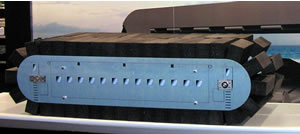New unmanned vehicles are being proposed to carry heavy cargo mission, such as tanks, armored vehicles and supply logistics over long distances, as well as from ship to shore hauling heavy vehicles and outsized cargo loads. Two concepts were unveiled at AUVSI 07 – the Hybrid Unmanned Air Vehicle (HUAV), developed by Lockheed Martin, and the T-Craft, designed by General Dynamics.

Combining buoyancy and aerodynamic lift, HUAV is creating an aircraft capable of carrying payloads of up to 2,500 – 12,000 pounds to an altitude of 20,000 ft, maintaining long persistence over the target area, at costs significantly lower than other manned or unmanned platforms. While the 250 foot long HUAV is designed for long persistence, cruising slowly at about 20 knots, it will also be able to move from one location to another at a top speed of 60 knots. HUAV will be ideally suited for long dwell missions (over 7 days without refueling) over low-threat environments. The large volume available for the payload enables the integration of sensors having very large aperture (up to 100 ft long, 20 ft wide). According to Lockheed Martin, the HUAV could be fully developed within 24 – 30 months and, if sufficiently funded, could fly by 2010.
Lockheed Martin is also planning a much larger version of the hybrid aircraft, capable of delivering heavy cargo over a range of 2,000 miles. The hybrid airship/aircraft will be constructed from high-strength fabrics providing buoyancy and aerodynamic lift. Its large size will accommodate outsized cargo, or 10 – 14 standard pallets weighing up to 50 tons. It will be equipped with four pusher thrust vectoring propellers and a landing system utilizing four air cushions enabling the airship to be airfield independent, land and takeoff from short unprepared surfaces. The crew controlling the hybrid aircraft will use on board weather monitoring and route planning to establish the best, safest flight route for the aircraft.
Completely different concept is pursued by General Dynamics, with the T-Craft Captive Air Amphibious Transporter (CAAT). The program addresses the Office of Naval Research (ONR) Seabasing Innovative Naval Prototype program, with an unmanned floating vessel capable of transverse sand bar and mud flats, offering the US Marines Corps with ‘feet dry on the beach” capability. CAAT will be able to carry twice the load of current amphibious landing crafts (LCAC), deployed from flat bed vessels such as LHDs and future Catamaran landing support ships. At AUVSI CAAT was displayed wit a load of two M-1 tanks and two HMMWVs. The autonomously controlled vessels will be propelled by linked buoyant cells forming a track-like propulsion system. Each vessel will have two tracks enabling forward and backward motion and steering by differential movement. The CAAT concept is currently under evaluation and, if funded, could become reality within a few years.
Topics covered in AUVSI 2007 review:
- Unmanned Systems – Flight and Ground Demonstration 2007
- UAV systems, including Combat UAVs
- Mini, Micro and Expendable UAV Systems
- The future USMC Tier II program
- High Altitude Long Endurance (HALE) Platforms
- Unmanned Transport Vehicles
- Mission Control Systems & Applications
- Advanced payloads for unmanned Systems
- UGVs and Controls Systems



















